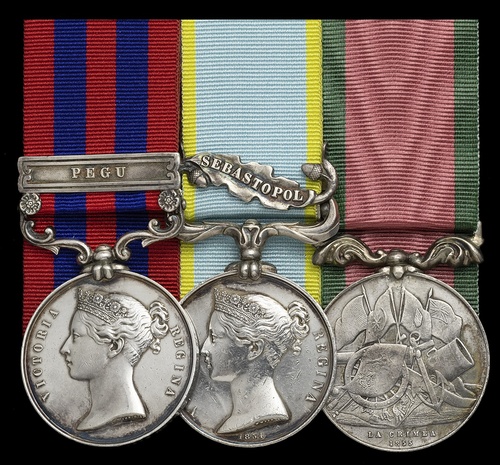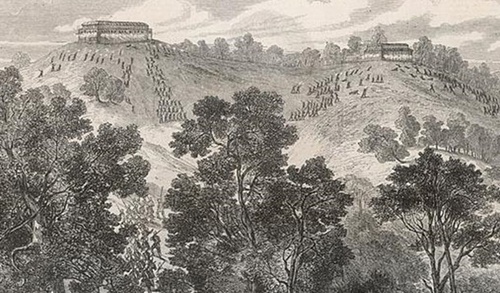Auction: 25001 - Orders, Decorations and Medals
Lot: 55
(x) The campaign group of three awarded to Major F. C. Griffin, Royal Artillery, who was killed in the attack on the fortified village of Ambiokh during the Bhootan campaign, when an enemy shell hit an open gunpowder cask in the midst of his small battery, killing three officers and four gunners outright
Crimea 1854-56, 1 clasp, Sebastopol (Lieut. F. C. Griffin Royal Artillery) contemporary engraved naming; India General Service 1854-95, 2 clasps, Umbeyla, Bhootan (Major F. C. Griffin. R.A.) officially impressed naming; Turkish Crimea 1855, Sardinian issue, unnamed, fitted with silver swivel-bar, recently mounted court-style, suspension, lightly polished otherwise good very fine or better (3)
Frederick Cockburn Griffin was born at Budock, Cornwall on 26 February 1832, the son of Cahterine and Captain Charles Griffin, Royal Navy. Joining the Royal Artillery as a Cadet on 28 January 1947 he was commissioned 2nd Lieutenant on 19 December 1849, being advanced Lieutenant on 3 October 1851.
In that rank he served with No. 1 Battery, 9th Battalion, Royal Artillery in the Crimea where he was one of two Lieutenants. This unit was present for the final bombardment of Sebastopol and eventually its fall, Griffin must have performed well during the campaign as he was advanced 2nd Captain not long later on 23 February 1956.
Further promoted Captain on 19 January 1961 he was posted to India in command of half of 'C' Battery, 19 Brigade R.A. Whilst there Griffin took part in the Umbeyla expedition- this was planned as a swift strike at a force of hostile tribesmen on what the British believed to be friendly ground. Sadly they were mistaken and the campaign became a slow slog with the same patches of ground being repeatedly fought over costing the British 1,000 casualties.
Again Griffin must have performed well during the fighting as he was advanced Brevet Major on 5 August 1864. That same year he was involved in the Bhootan campaign in command of two Armstrong Mountain guns which accompanied the Daling Column along with two 8-inch Mortars. This Column- one of four launched into Bhutan - left on 28 November 1864 under the command of Major C. J. S. Gough, V.C., and Major J. R. Pugh.
Their first major engagement was an attack on the fortified village of Ambiokh on 6 December 1864. This fortified village was located upon a thickly wooded hill below the fort of Dhalimcote- or Dalinkote, the name given upon Griffin's service papers- and defended by a solid stockade. As the British approached the Bhutanese could be seen removing the woodwork from the walls and tours in order to mitigate the effects of British artillery.
As the guns opened fire the infantry advanced, only to find themselves attacked by Bhutanese troops hidden in the forests. The village was soon taken in the face of heavy resistance and the attack continued towards the fort, which posed a tougher challenge. It was situated at the top of the hill, above a steep slope and proved a difficult proposition for both infantry and artillery. The mountain guns were brought up as closely as possible and began a covering fire for the infantry struggling up the hill and suffering heavy casualties in the face of a furious fire. The mortars were brought up to add to the covering fire and Griffin joined them to measure out the charges, British Battles on Land and Sea relates the tragedy that follows, stating:
'By this time, our mortars had been dragged to the ridge below the fort, and placed in position there, "The charge of powder," says Dr Rennie, "contained in the made-up cartridges being too great for so short a range, it was necessary to weigh out charges specially suited for it, and a barrel of gunpowder was opened for the purpose. At the second round from the mortars, one of the shells burst at the muzzle, and caused the explosion of the powder-cask. Major Griffen, who at the time was weighing the charges out, Lieutenant Anderson and Waller of the Royal Artillery, and four gunners of the same corps were killed by the explosion, while Lieutenant Collins of the Royal Engineers, and several artillerymen, were severely mutilated."
Brigadier Dunford had a narrow escape from being also a victim.'
Three of the four artillery officers, Major Griffin, Lieutenants E. A. Anderson and E. Waller, together with four of the gunners were killed outright, and Lieutenant W. H. Collins R.E. and a number of men were wounded. Fortunately the mountain guns were still in action and well manned, they breached the walls and the infantry poured into the fort, taking it and winning the battle.
Griffen is commemorated on a memorial at St. Paul's Cathedral, Calcutta alongside other officers killed during the Bhootan expedition; sold together with copied research.
Subject to 5% tax on Hammer Price in addition to 20% VAT on Buyer’s Premium.
Estimate
£1,000 to £1,400
Starting price
£800







